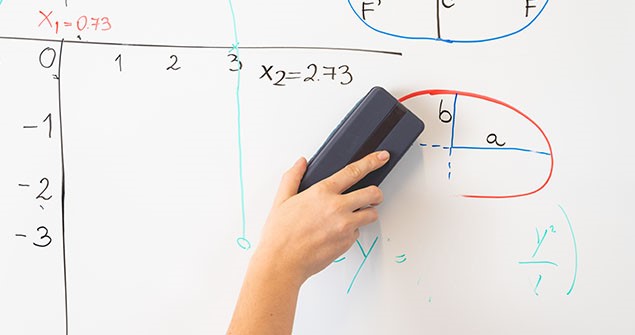
- A new whiteboard should always be cleaned prior to use.
- A damp, soft cloth is ideal for daily cleaning.
- A few simple tricks can remove permanent marks or “ghosting”.
Three types of whiteboard cleaning
Whiteboards are everywhere. Their exceptional reusability makes them a popular choice in schools, businesses, hospitals, restaurants and more. Styles range from wall mount and mobile to hand-held and easels. Teachers, students, administrators, coaches, nurses and employees use some form of whiteboard throughout the day during meetings, classes and impromptu discussions. Their popularity over blackboards exploded due to a smoother surface that allows for faster writing and erasing, and all with dry erase markers that leave no chalk residue. Still, much like blackboards, whiteboards also need regular cleaning to extend their life and keep looking new. There are three types of whiteboard cleaning. The first is upon receiving your whiteboard, the second is daily cleaning and the third is when accidents happen like using a permanent marker instead of a dry erase marker.
How to clean a new whiteboard prior to use
Some boards arrive with a thin plastic film over the whiteboard surface. It should peel off rather easily. Prior to use, first clean the surface with a whiteboard cleaner to remove dust, debris and any remaining residue. Follow by rinsing the board with clean water then dry with a soft cloth.
Daily whiteboard cleaning tips
After using a whiteboard, markings should always be erased. The longer they remain the more difficult they become to fully erase. For hard to remove dry erase marks, writing over them with a black dry erase marker and then erasing should do the trick. For general cleaning, a damp, soft cloth is only needed. However, if further cleaning is required a whiteboard cleaner is recommended. Manufacturers recommend avoiding ammonia-based cleaners (i.e., glass cleaners), wax-based cleaners (i.e., furniture cleaners) and abrasive cleaners (i.e., scouring powders) that will damage the whiteboard surface.
Tips to remove “permanent” marks from a whiteboard
Someone uses the wrong marker on a whiteboard – it happens. No problem. First, it’s important to write over the mishap with a dry erase marker then erase. If the marks remain, moisten a clean, soft cloth with isopropyl alcohol. Then, in a circular motion wipe the board to begin loosening the markings. Rinse with clean water and dry with a clean, soft cloth. Continue until all marks have been removed.
What is whiteboard ghosting and its causes?
Still, despite the best efforts with upkeep, there are times when dry erase marks are left behind while using the board. This is known as ghosting. If this occurs it is more than likely that one of the following is the culprit:1. Unclean felt erasers. It’s easy to overlook how much dry erase ink a felt eraser wipes off a board each day. Eventually, they too need cleaning to help prolong their use. A soft bristled brush can generally do the trick. With gentle up and down then side to side strokes, most of the dust can be removed. If further cleaning is required, combine a small amount of mild detergent with water. Dip the brush in the water and gently scrub in a circular motion, moving from top to bottom. Rinse the eraser in water then blot dry to remove as much water as possible. Finally, let it completely air dry before using again.
2. Wet erasing. Dry erase ink dries in seconds on a whiteboard. But if it is touched before it’s dry it will smear. An oily silicone polymer mixed with a solvent (typically an alcohol) makes dry erase ink slick to prevent color pigments from adhering to the board. In seconds the alcohol evaporates, leaving only the ink particles behind. A good rule of thumb is to allow dry erase ink 3 to 5 seconds to dry before erasing to prevent ghosting.
3. Repeated board use without frequent cleaning. Be sure to erase markings at the end of each day and use a whiteboard cleaner every two to three days to keep your board looking brand new.
4. Improper marker use. Use high quality, low odor dry erase markers. Low quality versions contain less of the oily silicone polymer which increases the likelihood of staining.
If you are shopping for whiteboards School Outfitters carries a wide selection. Choose from wall-mount whiteboards and whiteboard easels to student lapboards and enclosed dry erase boards for indoor and outdoor use. We also have all the accessories to use with your new board like felt erasers, whiteboard cleaners and quality dry erase markers. Should you have questions please give us a call at 1-800-260-2776 or contracts@schooloutfitters.com. We have a team of experts ready to help.


